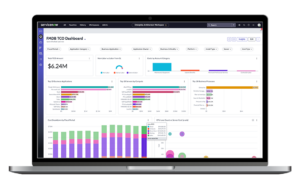Making decisions based on incomplete information can lead to unintended consequences. It’s a particular problem in IT decision-making, where companies often make decisions that inadvertently increase costs, introduce inefficiencies or create technical debt that hinders future growth.
Leaders in enterprise architecture (EA) and IT asset management (ITAM), for instance, frequently make high-stakes decisions based on the purchase price of software or assets alone.
What they eventually realize, however—potentially at great cost—is that purchase price is just one part of the total cost of ownership (TCO) of assets and technologies across the organization.
With that in mind, let’s look at four key areas where understanding TCO is crucial to IT decision-making, and how teams can get this information in the ServiceNow applications they’re already using.
IT Cost Optimization Cheatsheet: 5 Common Tactics and Anticipated Savings
1. Application Rationalization
Assessing, consolidating and eliminating redundant or underutilized software applications is one of the first places organizations start when looking to drive costs down.
That’s because when you eliminate an application, it’s not just the software that goes away—it also reduces costs in a variety of other areas, including maintenance, development and cloud consumption.
Identifying which applications to eliminate, however, demands a full understanding of TCO. A legacy application that costs $50,000 in licensing costs, for instance, might not be high on your priority list, until you take a look at the full picture and see that it’s costing the organization over $1M in labor to keep it on life support.
Another example comes from a customer who was looking to optimize costs by migrating away from Oracle databases. By leveraging a TCO-driven cost model, they were able to map out all applications that relied on Oracle and identify those that could be migrated to a more cost-effective alternative—at 85% lower cost.
This transformation was only possible because they had full financial and operational visibility into their application portfolio. Without it, they could not have eliminated all of their hidden costs, nor demonstrated the overall savings to the organization by making the move.
2. Cloud and AI Governance
 Evaluating the financial implications of digital transformation initiatives is another area where understanding TCO is vital. Without this information, digital transformation projects can quickly turn into costly technology experiments, with no way to tell if they are truly delivering ROI.
Evaluating the financial implications of digital transformation initiatives is another area where understanding TCO is vital. Without this information, digital transformation projects can quickly turn into costly technology experiments, with no way to tell if they are truly delivering ROI.
Cloud adoption is a prime example here. There’s no question that migrating IT to the cloud has transformed the way organizations operate in terms of improving efficiency and agility while reducing infrastructure costs.
At the same time, financial governance was often lacking in the early days of cloud migration, leading to rampant cloud consumption without a firm grasp of costs or operational impacts.
Today, AI adoption is following a similar trajectory, with many businesses investing heavily in the technology while struggling to measure ROI. Many companies don’t know where all of their AI costs are spread across the organization, particularly when they are building their own AI solutions as is often the case.
The big lesson here: smart transformation investment requires connecting operational and financial data for a complete view of TCO. This is what allows you to see exactly which applications your projects are supporting and connect spending directly to them. With accurate TCO data in hand, businesses can track costs in real-time, forecast spending trends and make course corrections before costs spiral out of control.
3. Portfolio Investment Prioritization
Every organization has a backlog of IT and business projects competing for funding. Deciding which initiatives to invest in requires more than just an operational view—it also demands financial justification.
In other words, it’s not just about making the right technological choices, but also the right financial choices for the enterprise.
Consider, for instance, an organization with 100 potential projects but only enough budget to fund a handful of them. Many people do their own calculations to try to understand where to focus transformation efforts, but these don’t necessarily capture the true financial or operational impact.
TCO based on financial and operational data from the general ledger—not high-level corporate systems—provides the foundational building blocks for making these types of decisions. That means instead of choosing investments based on perceived value, leaders can quantify the dollars that would be saved, shifted or introduced across all of IT.
Imagine, for example, a company that spends $10M to build a new solution, only to find it costs $1M annually to run, a number that increases 5% each year. Over time, this starves many organizations, which is why you see build portfolios getting smaller and smaller over time.
Knowing the actual implication of digital transformation, not just from a dollar perspective but also in terms of what it will take to run it, gives companies the power to get ahead of this common problem.
4. Addressing Tech Debt
Technical debt (or tech debt) is a growing concern for companies in terms of maintenance costs, security risks and constraints on innovation. That said, addressing tech debt is often low on the priority list because it’s hard to measure and doesn’t always have an urgent business case.
A TCO-driven approach to managing tech debt provides a way forward that allows organizations to quantify the financial impact of outdated technology and justify modernization investments.
Imagine a company with an aging ERP system, for example, that is having to spend increasing amounts on maintenance and support. Without a full picture of costs—including labor, downtime and compliance risks—leaders might delay necessary upgrades.
What TCO does is allow them to make a compelling case for modernizing the system, demonstrating not just the immediate cost but also the long-term savings and operational benefits.
The Challenge of Getting Accurate TCO Data
Some companies that use ServiceNow IT Asset Management (ITAM) or Enterprise Architecture (EA) will say they’re already using these solutions to track TCO.
There’s just one big problem with how they’re doing it: In the majority of cases, companies are simply using the purchase price for the software as if it’s the same thing as TCO.
In doing so, they fail to capture significant parts of TCO, such as:
- Internal and external labor costs
- Infrastructure and cloud hosting expenses
- Compliance, security and risk management costs
- Support and maintenance over the lifecycle of the asset
- Training, change management and operational disruptions
The implication is that they’re only seeing one part of the true scope of costs, resulting in clouded decision-making and an inability to tie spending to value across IT.
Adding TCO Fuel to ServiceNow
Nicus Financial Management Database (FMDB) on ServiceNow integrates directly with key ServiceNow applications like IT Asset Management and Enterprise Architecture pulling data from the financial book of record to deliver an accurate, credible and defensible TCO for all assets across their lifecycle.
This enables companies to:
- Gain 24/7 real-time insights into costs across applications, projects and infrastructure
- Accurately cost future state changes for strategic IT and business alignment
- Establish a single source of truth for TCO on ServiceNow, eliminating guesswork, fuzzy math and manual data errors
- Maximize the value of ServiceNow ITAM and EA by equipping them with accurate, real-time financials
For ITAM leaders, this means accurate cost visibility across assets, improved decision-making and more effective cost optimization. For EA it adds a financial lens to IT portfolios, enabling data-driven investment prioritization and transformation planning.
In both cases, it’s about achieving the ultimate grand slam: knowing what your true costs are, knowing where value is being delivered, and being able to measure all of it back to the organization.
Case study: Learn how AmFam used Nicus to reveal true TCO and transform IT decision-making







